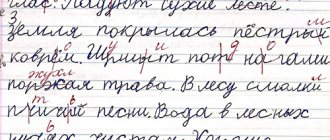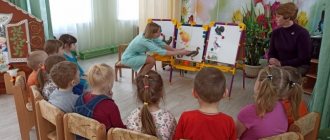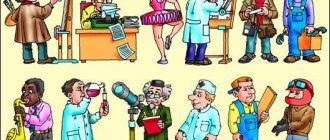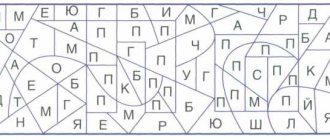Classification and types of dysgraphia
Depending on the violation or immaturity of a particular writing process, 5 forms of dysgraphia are distinguished:
- Articulatory-acoustic dysgraphia :
this form of dysgraphia is manifested in the writing of letters that indicate sound during pronunciation, i.e.
the child writes exactly the way he pronounces the word. The causes of this type of dysgraphia are impaired pronunciation and phonetic-phonemic hearing (dyslalia, rhinolalia, dysarthria). An example of this type of dysgraphia: “cold - good”, “gray - gray”, “flowers - blooms”, etc. - Acoustic dysgraphia: this form of dysgraphia manifests itself in the replacement of hissing/whistle, hard/soft and voiced/voiceless letters in writing. The reason leading to the appearance of this type of dysgraphia is a violation of the recognition of close-sounding speech sounds, that is, a violation of phonemic recognition. Examples: “dead end-tube”, “jump-jump”, “creep-mushroom”, etc.
- Dysgraphia, associated with a violation of language analysis and synthesis, manifests itself in a distortion of the structure of the text. Letters are omitted, syllables and letters are rearranged, words are spelled together, prefixes and/or endings are separated from the base of the word, and often all words in a sentence are spelled together. The cause of dysgraphia due to a violation of language analysis and synthesis is the inability to differentiate words and syllables. Examples of violations: “table-sotl”, “it’s raining - you’re coming”, “on the table-table”, etc.
- Agrammatic dysgraphia : It can be said to be a tongue-tied form of writing. With this form, the correct use of case endings is violated, incorrect placement of gender or number is observed, difficulty in applying rules, incorrect placement of a soft sign, inability to find a spelling, violation of the sequence of words in a sentence, etc. For example: “many trees - many trees”, “my dad - my dad”, “kitten - kittens”, etc.
- Optical dysgraphia :
the most common form of dysgraphia.
With this form of dysgraphia, the child experiences difficulty visually distinguishing similar letters. The reason for its occurrence is insufficiently developed skills of visual recognition of symbols, poorly developed visual memory, as well as the synthesis of the image seen, the image in memory and the spatial representation of this image. Most often, letters that are similar in spelling but differently located in space are replaced. Letters can be replaced either by those existing in the language or by non-existent ones, but with the preservation of similar elements (B-D, T-Sh, I-Sh, P-T, ZH-H, L-M, Ts-Shch), perhaps the spelling of letters is mirrored (letters I, E, Z). also includes mirror writing or, as it is also called, Leonardo’s writing or handwriting .
Dysgraphia – what is it?
Dysgraphia is a writing disorder that is not associated with ignorance of the rules of grammar. The disorder is manifested by persistent, typical errors:
- replacing letters with similar sounds: b-p, t-d;
- incorrect endings of words;
- continuous writing of prepositions;
- no indentation;
- "mirror" letter;
- illegible handwriting and a number of others.
Example
A child unfamiliar with the rules of grammar will write the word “sentence” as “sentence”, and a dysgraphic person will write “breathing”.
Mechanisms of occurrence
From the point of view of neuropsychology, the cause of dysgraphia is the immaturity of higher mental functions, which include:
- visual analysis and synthesis;
- spatial representation;
- differentiation of speech sounds;
- phonemic and syllabic analysis and synthesis;
- dividing sentences into words;
- attention;
- memory;
- emotional-volitional sphere.
Mastering written language requires the coordinated work of the whole brain. He must have time to process information coming from the organs of hearing, vision, and tactile sensations. This is a colossal load that every first grader faces. But over the course of the year his skills improve.
If at the end of the first school year there is no improvement, the child makes the same mistakes, is restless, distracted and lags far behind his peers, then he should be checked for dysgraphia. The violation does not go away on its own, but is successfully corrected by specialists.
Leonardo's handwriting: who are ambidextrous people?
Leonardo's letter or handwriting is writing with the left hand in a mirror image with a change in inclination relative to the vertical and/or horizontal axis. With this type of handwriting, all words and letters look as if they were reflected in a mirror. Leonardo's handwriting appears in ambidextrous people.
Mirror handwriting, or Leonardo handwriting, named after the ambidextrous Leonardo da Vinci
Who is ambidextrous ?
Ambidextrous people are people with equally dominant hemispheres of the brain, who have the ability to write with both hands, incl. and in mirror image.
The number of ambidextrous people on the planet is constantly growing, as is the number of pure left-handers. Ambtides later begin to crawl, walk, and talk. This happens for the reason that a person is born with two identically developing hemispheres of the brain, and the left hemisphere begins to gain leadership from the moment the child begins to be interested in speech - i.e. with attempts at onomatopoeia. But the right hemisphere does not always give up easily and cede the main role. It becomes like a tug of war - each hemisphere tries to dominate and interhemispheric conflict arises. An ambidextrous child has sudden mood swings, is whiny, and restless. When learning to write, the absence of the dominant hemisphere complicates the task of distinguishing, memorizing the contours of letters, differences in the sound of similar sounds and identifying the corresponding letter, and difficulty with the spatial arrangement of elements when writing. However, among ambidextrous people there are many talented and even brilliant people, and an example of this is Leonardo da Vinci, who wrote his notes in his diary with his left hand in a mirror image (which is why the mirror handwriting was called Leonardo's letter in his honor).
Causes of dysgraphia
How and in which children can dysgraphia occur? What are its reasons? Dysgraphia in children begins to appear during the period of learning to write. You can talk about the presence of dysgraphia no earlier than the age of 8-9 years (i.e., approximately the second grade of secondary school). By this age, children have already mastered the skills of stable writing and constant mistakes of the same type should attract the attention of adults.
The process of writing is a rather complex process for our nervous system. Here it is necessary to involve many higher nervous functions: recognition of a symbol, evoking its image in memory, the relationship between image and sound, fine motor skills of the hand when writing, assessing the similarity of the image to the image in memory. Since many higher nervous functions are involved in writing, there can be many reasons for writing disorders. The following main reasons are distinguished:
- Organic disorders : this is a developmental disorder in the prenatal and postnatal periods, trauma during childbirth, asphyxia, meningitis, frequent severe illnesses of the child that cause depletion of his nervous system, late maturation of brain systems, overtrained left-handedness.
- Psychological and social causes of dysgraphia can be mental retardation (MDD), bilingualism, unclear speech of others, teaching a child to write too early when he is not ready for it, inattention of adults to the peculiarities of the child’s speech (failure to pronounce some letters, replacement of syllables and other speech disorders and etc).
Most often, dysgraphia manifests itself in children with speech disorders (especially if speech defects were not eliminated before the start of literacy training), with a history of organic brain damage (minimal brain dysfunction, encephalopathy, etc.), who have suffered a brain injury, with a depleted nervous system and immature areas of the brain.
Dysgraphia can also be detected in adults . The cause of dysgraphia in adults is a disruption of higher mental functions due to an infectious disease or brain injury. Dysgraphia in adults occurs in approximately 10% of cases of the total number of patients with identified dysgraphia.
Dysgraphia is not considered an independent disorder. It often accompanies various neurological dysfunctions and disorders, as well as auditory, motor, speech and visual pathologies.
CogniFit online general cognitive test : use a scientifically developed program to quickly and accurately assess your brain health, discover your cognitive strengths and weaknesses. The results of this neuropsychological test help determine whether a person's cognitive changes are normal or whether a neurological disorder is suspected. Get your result in less than 30-40 minutes. CogniFit is the most recommended and used cognitive testing program by professionals.
Innovative general cognitive test CogniFit
Prevention of dysgraphia in a child
The timely development of visual, auditory perception, and fine motor skills serves as a prevention of the dyslexia disorder. Parents do not need to rush their child to count and write, they need to be careful about early learning, all loads should be given in doses and in the form of games. Games such as “Guess what the object is” are suitable - the child is shown only the boundaries of the images by which he must identify the object; “Search for the unnecessary” - the child needs to identify an unnecessary object.
For adults, prevention will include correcting handwriting, reading fiction, and developing visual images.
If dyslexia and dysgraphia are diagnosed in an adult or child, treatment is simply necessary. To overcome the difficulties that these disorders bring, treatment should only be carried out by an experienced specialist .
At the Itel Center for Pedagogical Diagnostics and Correction of Dysgraphia, your problem will be taken care of by professional doctors and speech therapists. To eliminate problems, advanced techniques and development programs are used. Individual, targeted and methodologically well-structured correction classes contribute to the gradual and confident reduction of dysgraphia in children.
Children often experience both dysgraphia and dyslexia at the same time, the treatment of which is interrelated; the cause of these problems is usually the same. Experienced and qualified speech therapists will come to help you and your child . Dysgraphia, although not very quickly, is curable, and timely measures taken to correct the deviation will allow the child to easily catch up with their peers.
Prices for the treatment of dysgraphia in children and adults – please call Moscow, 688-70-86.
WhatsApp: +79653544005 For questions regarding dysgraphia correction, call. 8 (985) 688-70-85 or e-mail Sign up for a consultation using the form on the website
Prevention of dysgraphia
Many parents wonder: what is the prevention of dysgraphia? How to prevent the development of this disorder?
First of all, be attentive to your child. If a child speaks late or has problems with sound pronunciation or phrasing, he is at risk. Activities aimed at developing speech and phonetic-phonemic hearing are necessary. Both the speech therapist and the mother should work with the child. If organic disorders are observed, then doctors must be involved in prevention to provide medical assistance to the child.
Thus, summarizing all of the above, in the risk group for developing dysgraphia:
- left-handed or ambidextrous child
- “retrained” left-hander,
- bilingual child,
- if the child has already worked with a speech therapist before,
- when writing, misses or confuses letters, does not complete words, etc.,
- there are disorders of phonetic perception,
- the child writes as he speaks. What else should you pay attention to?
- the child has problems with memory and attention,
- The child went to school early.
, neuropsychological correction of children can provide significant assistance . These classes help:
– develop a sense of rhythm, which facilitates the division of speech into words and syllables,
– develop and improve spatial orientation and spatial perception in a child - this is necessary to distinguish similar elements of letters and accurately correlate their location in space,
– improve hand-eye coordination, the child’s relationship with his own body and body control skills – this is important for writing, as it helps develop fine and gross motor skills.
Bilingual children need help when starting to study in one of the languages or changing the language of instruction. Help should be in the form of similar activities, as for ordinary dysgraphic children.
The prevention process is lengthy - it cannot be said that several exercises or activities are sufficient. After completing a course of corrective classes/measures, it is necessary to take a snapshot after some time and find out how much the situation has changed. After this, a decision is made on the necessity or sufficiency of the measures taken.
Types of writing disorders with dysgraphia
There are several types of dysgraphia, which can occur either alone or in various combinations. To select an effective method for correcting dysgraphia, an experienced specialist first identifies the symptoms and then creates a correction program.
The most common is the so-called acoustic one , caused by insufficient awareness of the sound side of the word, leading to the replacement of the corresponding letters in the letter (tree - tree). Articulatory-acoustic dysgraphia is expressed by the use of the same type of sound substitutions not only in writing, but also in oral speech. Optical dysgraphia is caused by the difficulty of assimilating visual images that have the same or similar graphic elements (G and T, Shch and Sh).
Dysgraphia, based on a violation of language analysis and synthesis, is expressed in the rearrangement, omission or addition of letters and syllables, not completing words or writing prepositions together and separately writing prefixes. Agrammatic dysgraphia is caused by underdevelopment of the grammatical structure of speech and manifests itself in the inability to apply the learned grammatical rules in practice.
What to do if a child has dysgraphia? Useful exercises and games
Correction of dysgraphia. What to do if you or your child is diagnosed with dysgraphia? How to fix the situation?
First of all, you need to contact a specialist who will correctly determine the type of violation and select the appropriate correction program.
Corrective exercises will help cope with childhood dysgraphia
What can you do yourself at home ? You can do the following corrective exercises at home:
– Exercises and games aimed at developing phonemic awareness:
- Game “Catch the Letter”: the adult says which letter needs to be “caught” (usually a vowel), and then pronounces a series of words. When pronouncing a word with a given letter, the child must clap his hands.
- Game “Catch the letter-2”: an adult names the letter and then pronounces various words. After each word, the child must say where in the word this letter was (at the beginning, in the middle or at the end). Learn logo rhymes with your child for a certain letter, practicing pronunciation, and then complicate the task - at the same time as pronouncing the rhyme, you need to lay out some given figure from matches (sticks).
– Develop spatial perception: sculpt letters, draw letters, put them together from sticks, make appliqués, disassemble letters into spare parts and assemble new ones, play with letters – let the child feel tactilely what a letter is. Pronounce the sound simultaneously with tactile perception, fixing this correspondence in memory.
– Play spatial awareness games:
- The child sits with his back to the adult, and the adult says a word from behind him. The child must indicate in which direction the sound was.
- Write graphic dictations.
- Play games like “fly” - in a 3x3 square, a fly is drawn in the central cell. An adult names the direction of movement of the “fly” - up-down-right-left... etc. The child follows with his eyes where the fly flies. The child’s task is to clap his hands and thereby catch the fly if it flies outside the square. At the initial stage, the child can help himself with a pencil or finger - noting where the fly is now, then it is necessary to leave only oculomotor movements. You can increase the square, gradually adding a new level, up to the game “fly in the cube”.
– Develop your child’s general vocabulary , encourage reading if he already reads, or use reading trainers if the child does not read well or has problems reading.
– Play recognizing objects and letters when they are incompletely drawn (half a figure/letter, noisy figures/letters, several images superimposed on each other - the child needs to select the one he needs and circle it).
– Read “upside down” texts : replace several words in the text with words written upside down or backwards. A few words in a few sentences are enough.
– Game “find the letter”: in the given text you need to underline all the given letters (or icons in rows of icons, if the child does not yet know how to read). This exercise develops recognition and attentiveness.
– Make up simple sentences and stories based on pictures
– Read the “word fields”, highlighting the words in them
– Solve anagrams
– Look for the missing letter in the words: the adult writes words, omitting one letter and indicating the place of the omission, and the child must say which letter is missing.
– Go through mazes : first by running your fingers through the maze, then by drawing a line with a pencil, and after that - only with your eyes.
– Develop a sense of rhythm : learn rhymes and tap out the rhythm of the verse, clap on a certain syllable when pronouncing a number of words, play the game “repeat the rhythm.”
– Ask the child to name how many letters are in a word, say how many syllables are in a word, how many words are in a sentence, how many sentences are in a text (the text and words must be perceived by ear).
These and many other corrective exercises for dysgraphics will help overcome this problem. These same exercises are also suitable for adults. Once again I want to say that correction of dysgraphia is a long and labor-intensive process. You need to start working in this direction at the first signs of impairment (speech, word formation, impaired object recognition, etc.).
What to do if a child does not want to learn to write?






